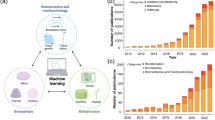Abstract
The integration of biology in materials science and engineering can be complicated by the lack of a common framework and common language between otherwise disparate disciplines. History may offer a valuable lesson as modern materials science and engineering itself resulted from the integration of traditionally disparate disciplines that were delineated by classes of materials. The integration of metallurgy, ceramics, and polymers into materials science and engineering was facilitated, in large part, by a unifying paradigm based upon processing-structure-property relationships that is now well-accepted. Therefore, a common paradigm might also help unify the vast array of perspectives and challenges present in the interdisciplinary study of biomaterials, biological materials, and biomimetic materials. The traditional materials science and engineering paradigm was modified to account for the adaptive and hierarchical nature of biological materials. Various examples of application to research and education are considered.
Similar content being viewed by others
References
R. Langer, “Biomaterials for Drug Delivery and Tissue Engineering,” MRS Bull., 31(6) (2006), pp. 477–485.
G.M. Whitesides and A.P. Wong, “The Intersection of Biology and Materials Science,” MRS Bull., 31(1) (2006), pp. 19–27.
M.H. Friedman, “Traditional Engineering in the Biological Century: The Biotraditional Engineer,” J. Biomech. Eng., 123(12) (2001), pp. 525–527.
L.E. Murr, “Biological Issues in Materials Science and Engineering: Interdisciplinarity and the Bio-Materials Paradigm,” JOM, 58(7) (2006), pp. 23–33.
M.A. Meyers et al., “Biological Materials: Structure and Mechanical Properties,” Prog. Mater. Sci., 53 (2008), pp. 1–206.
L.L. Hench and J.M. Polak, “Third-Generation Biomedical Materials,” Science, 295 (2002), pp. 1014–1017.
D.F. Williams, “On the Mechanisms of Biocompatibility,” Biomaterials, 29 (2008), pp. 2941–2953.
K.C. Dee and R. Bizios, “Mini-Review: Proactive Bio materials and Bone Tissue Engineering,” Biotechnol. Bioeng., 50(4) (1996), pp. 438–442.
D.L. Butler, S.A. Goldstein and F. Guilak, “Functional Tissue Engineering: The Role of Biomechanics,” J. Biomech. Eng., 122(12) (2000), pp. 570–575.
D. Peer et al., “Nanocarriers as an Emerging Platform for Cancer Therapy,” Nat. Nanotechnol., 2 (2007), pp. 751–760.
M. De, P.S. Ghosh, and V.M. Rotello, “Applications of Nanoparticles in Biology,” Adv. Mater, 20 (2008), pp. 4225–4241.
P. Wu, D.G. Castner and D.W. Grainger, “Diagnostic Devices as Biomaterials: A Review of Nucleic Acid and Protein Microarray Surface Performance Issues,” J. Biomater. Sci. Polymer Ed, 19(6) (2008), pp. 725–753.
M. Sarikaya et al., “Molecular Biomimetics: Nanotechnology through Biology,” Nat. Mater, 2 (2003), pp. 577–585.
D.F. Williams, The Williams Dictionary of Biomaterials (Liverpool, U.K.: Liverpool University Press, 1999).
M.A. Meyers, A.M. Hodge, and R.K. Roeder, “Biological Materials Science and Engineering: Biological Materials, Biomaterials, and Biomimetics,” JOM, 60(6) (2008), pp. 21–22.
D.F. Williams, “On the Nature of Biomaterials,” Biomaterials, 30 (2009), pp. 5897–5909.
K.C. Dee, D.A Puleo, and R. Bizios, Tissue-Biomaterial Interactions (New York: John Wiley and Sons, 2002).
M.C. Flemings, K.F. Jensen, and A. Mortensen, “Proposal for a Generic Materials Processing Course,” MRS Bull., 15(8) (1990), pp. 35–36.
G.L. Liedl, “The Emerging Undergraduate Curricula in Materials Science and Engineering,” MRS Bull., 15(8) (1990), pp. 31–34.
Materials and Man’s Needs: Materials Science and Engineering, Vol. 3, The Institutional Framework for Materials Science and Engineering, Supplementary Report of the Committee on the Survey of Materials Science and Engineering (Washington, D.C.: National Academy of Sciences, 1975), http://www.nap.edu/catalog/10438.html.
Materials Science and Engineering for the 1990s: Maintaining Competitiveness in the Age of Materials (Washington, D.C.: National Academy Press, 1989), http://www.nap.edu/catalog/758.html.
The Future of Materials Science and Materials Engineering Education, A report from the Workshop on Materials Science and Materials Engineering Education (Arlington, VA: National Science Foundation, 2008), httpj/www.nsf.gov/mps/dmr/mse_081709.pdf.
L.H. Schwartz, “Undergraduate Materials Education 2010: Status and Recommendations,” JOM, 62(3) (2010), pp. 34–70.
K.P. Trumble, K.J. Bowman, and D.R. Gaskell, “A General Materials Processing Curriculum,” J. Mater. Education, 18(3) (1996), pp. 117–123.
E. Arzt, “Biological and Artificial Attachment Devices: Lessons for Materials Scientists from Flies and Geckos,” Mater. Sci. Eng. C, 26 (2006), pp. 1245–1250.
M.F. Ashby, Materials Selection in Mechanical De sign (Oxford, U.K.: Pergamon Press, 1992).
M.C.H. van der Meulen and R. Huiskes, “Why Mechanobiology? A Survey Article,” J. Biomechanics, 35(4) (2002), pp. 401–414.
D.E. Stokes, Pasteur’s Quandrant: Basic Science and Technological Innovation (Washington, D.C.: Brookings Institute Press, 1997).
E. Hodnett, The Art of Problem Solving (New York: Harper, 1955).
B. Prasad, Concurrent Engineering Fundamentals. Integrated Product and Process Organization (Edgewood Cliffs, NJ: Prentice Hall, 1996).
B. Yazdani and C. Holmes, “Four Models of Design Definition: Sequential, Design Centered, Concur rent and Dynamic,” J. Eng. Design, 10(1) (1999), pp. 25–37.
D. L. McDowell, “Simulation-Assisted Materials Design for the Concurrent Design of Materials and Products,” JOM, 59(9) (2007), pp. 21–25.
G.B. Olson, “Computational Design of Hierarchically Structured Materials,” Science, 277 (1997), pp. 1237–1242.
K. Thornton et al., “Computational Materials Science and Engineering Education: A Survey of Trends and Needs,” JOM, 61(10) (2009), pp. 12–17.
J.A. Nychka and M.M. Gentleman, “Implications of Wettability in Biological Materials Science,” in this issue.
K. Bowman, Mechanical Behavior of Materials (New York: John Wiley and Sons, Inc., 2004).
J.M. Deuerling et al., “Specimen-specific Multiscale Model for the Anisotropic Elastic Constants of Human Cortical Bone,” J. Biomechanics, 42(13) (2009), pp. 2061–2067.
J.W. Ager III, G. Balooch, and R.O. Ritchie, “Fracture, Aging, and Disease in Bone,” J. Mater. Res., 21(8) (2006), pp. 1878–1892.
J.J. Kruzic and R.O. Ritchie, “Fatigue of Mineralized Tissues: Cortical Bone and Dentin,” J. Mech. Behav. Biomed. Mater., 1(1) (2008), pp. 3–17.
L.M. Liz-Marzan, “Tailoring Surface Plasmons through the Morphology and Assembly of Metal Nanoparticles,” Langmuir, 22 (2006), pp. 32–41.
J. Andrade, “Biomaterials I: Past, Present, and Future,” Biomedical Engineering Education Summit (Arlington, VA: Whitaker Foundation, 2000).
Author information
Authors and Affiliations
Corresponding author
Rights and permissions
About this article
Cite this article
Roeder, R.K. A paradigm for the integration of biology in materials science and engineering. JOM 62, 49–55 (2010). https://doi.org/10.1007/s11837-010-0108-5
Published:
Issue Date:
DOI: https://doi.org/10.1007/s11837-010-0108-5




